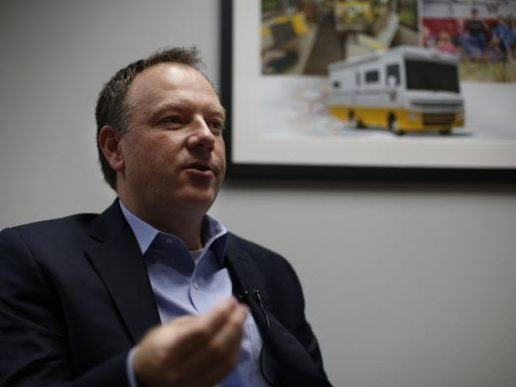
Speaking to analysts on a conference call discussing fourth-quarter earnings, Winnebago President and CEO Michael Happe said the manufacturer’s backlog is larger than it reported Wednesday.
Happe said Winnebago is making zero open orders in production schedules. Everything the manufacturer makes has a dealer name or a retail name on it. When Winnebago receives a backlog order, he said, teams work to schedule production in the future, anywhere from three to 12 months from order receipt.
“We had several products with significant orders that we cannot yet find production capacity for,” Happe said. “So, we took those out of the backlogs that we reported for the fourth quarter because we felt that was the right thing to do from an integrity standpoint.”
Winnebago reported a combined $4 billion backlog, including $1.7 billion in towables backlog. Happe said towable backlog remained strong, with Grand Design RV accounting for the predominant share.
Pricing and inflationary effects also were prime discussion points. Happe opened by saying consumer demand remained strong, with numerous RV buyers from 2020 and 2021 already trading up. Material and component cost increases from suppliers are continuing, with Happe saying there was limited visibility on when they would dissipate.
“Given the levels of cost input inflation that we have witnessed over the past year, we are thoughtfully working to mitigate these cost increases with our internal cost savings initiatives,” Happe said. “However, it has also been necessary for us to pass price increases that serve to offset the inflationary pressures.”
Happe said price increases vary from mid-single-digit percentages to more than 20%. He gave examples of ways pricing increases might abate, including the rollback or elimination of tariffs introduced in 2018 and any dips in inflation over time.
“What we can’t tell is what the impact of increased demand will have on the ability for pricing to be held in the future,” he said. “I’m optimistic that we will not see a significant whiplash backward in prices, but it’s difficult to answer with any certainty.”
Pricing in high-demand RVs is tied to the market, Happe said, but increasing prices to match cost occurred more in the past 12 months than any time in his six years at Winnebago.
“There are times where we can see future costs coming at us, based on sources that we trust in terms of projection or suppliers that are transparent in what they intend to do. In those cases, we will try to take proactive action,” Happe said. “In other cases, we are chasing. Never before have we seen suppliers come to us and implement cost changes the next day. We are dealing with sometimes weekly price increases in an unexpected nature and then reacting to that.”
Winnebago is working with dealers to protect pricing throughout the cycle. Happe said varying degrees of protection are provided on retail-sold units – orders in which consumers have placed deposits before the RVs were built – but Winnebago has trouble protecting the price when “we don’t know what the true cost of that unit might be … if we haven’t even built it yet.
“We have offered consistent (dealer) support through the years. That position has evolved currently because of the potential time it would take to deliver a retail unit to that customer and the potential change in input costs,” he said. “It will depend on the dealer. It will depend on the model. It will depend on the brand. It will depend on the time gap between when that retail deposit is put down and when that unit might be delivered. Those are daily conversations between our teams and our dealers.”
Happe finished by discussing the semiconductor chip shortage effect on motorhome production. He said Winnebago is managing the process better but the issue is “dramatically no different today than it was six to nine months ago.
“We have very strong relationships with our motorized chassis suppliers. Our teams are in constant, daily contact with them about our future forecasts and needs. So, we are able to really forge a production schedule around our mutual forecast and commitment.”




